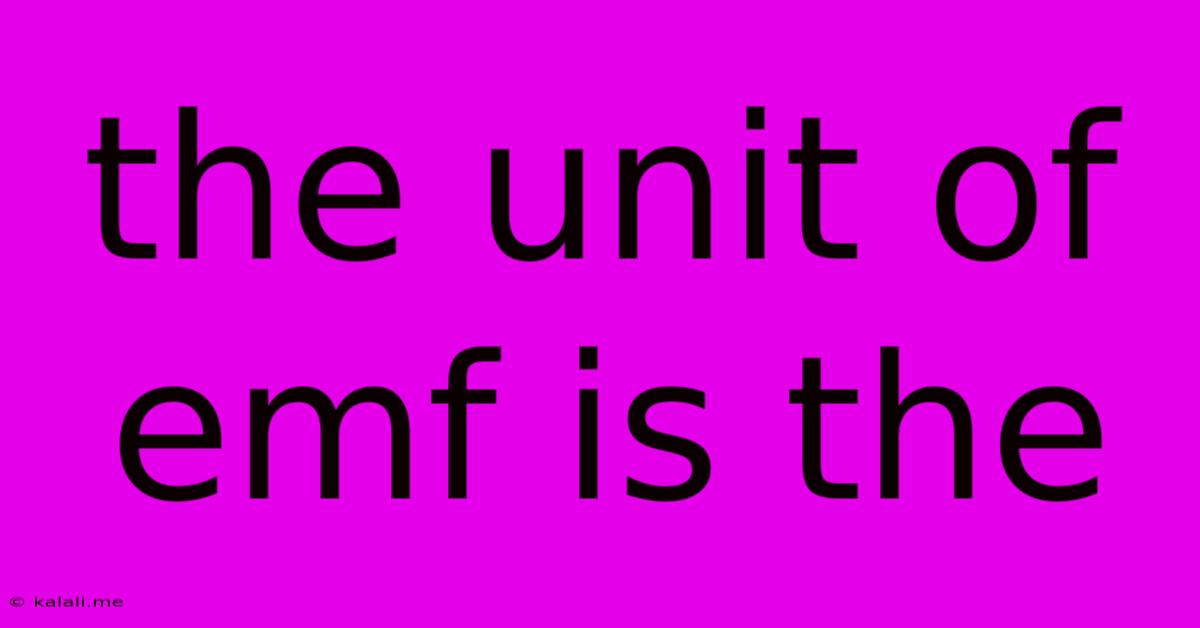The Unit Of Emf Is The
Kalali
Jun 13, 2025 · 3 min read

Table of Contents
The Unit of EMF: Understanding Electromotive Force
The electromotive force (EMF) is a crucial concept in understanding electricity and how it drives current in circuits. But what exactly is EMF, and what unit is used to measure it? This article will delve into the definition of EMF and definitively answer the question: the unit of EMF is the volt.
What is Electromotive Force (EMF)?
Electromotive force, often shortened to EMF, isn't actually a force in the traditional Newtonian sense. Instead, it represents the potential difference between two points in an electric circuit that can drive an electric current. Think of it as the electrical "pressure" that pushes electrons through a conductor. This pressure is generated by various sources, such as:
- Batteries: Chemical reactions within a battery create a potential difference between its terminals.
- Generators: Mechanical energy is converted into electrical energy, generating an EMF.
- Solar cells: Light energy is converted directly into electrical energy, producing an EMF.
- Fuel cells: Chemical reactions involving fuel (like hydrogen) and an oxidant (like oxygen) generate an EMF.
EMF is responsible for driving the flow of charge carriers (usually electrons) within a circuit. It's important to distinguish EMF from potential difference (voltage): while closely related, EMF is the source of the potential difference, whereas voltage is the measurement of the potential difference between two points in a circuit.
Why is the Volt the Unit of EMF?
The unit of EMF, as well as potential difference, is the volt (V). This is named after Alessandro Volta, the inventor of the voltaic pile, one of the earliest forms of a battery. One volt is defined as the potential difference between two points in a circuit where one coulomb of charge gains or loses one joule of energy.
This means:
1 Joule (J): The unit of energy. 2 Coulomb (C): The unit of electric charge. 3 Volt (V): The unit representing the energy per unit charge (J/C).
Therefore, 1 Volt = 1 Joule/Coulomb.
Measuring EMF
EMF can be measured using a voltmeter, a device that measures the potential difference between two points in a circuit. It's crucial to connect the voltmeter in parallel with the EMF source to accurately measure its value. When measuring the EMF of a battery, for example, the voltmeter should be connected across the battery terminals without any load connected.
EMF and Internal Resistance
It's important to note that real-world EMF sources have internal resistance. This resistance causes a voltage drop within the source itself, meaning the terminal voltage (the voltage actually available at the terminals) is slightly lower than the EMF. The relationship between EMF (E), terminal voltage (V), internal resistance (r), and external resistance (R) is given by Ohm's Law: V = E - Ir, where I is the current flowing through the circuit.
Understanding the unit of EMF, the volt, is fundamental to grasping electrical circuits and their behavior. By understanding the concept of EMF and its measurement, you can better analyze and design electrical systems.
Latest Posts
Latest Posts
-
First Psychological Laboratory Was Established By
Jun 14, 2025
-
A Deuterium Nucleus Contains Which Of The Following
Jun 14, 2025
-
The Clear Sky Appears Blue Because
Jun 14, 2025
-
Can I Change Sat Test Date
Jun 14, 2025
-
How Many Significant Figures Are In 500
Jun 14, 2025
Related Post
Thank you for visiting our website which covers about The Unit Of Emf Is The . We hope the information provided has been useful to you. Feel free to contact us if you have any questions or need further assistance. See you next time and don't miss to bookmark.